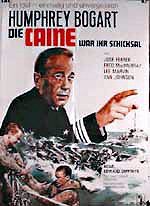 :
Study
Questions: Week Eight
:
Study
Questions: Week Eight  :
Study
Questions: Week Eight
:
Study
Questions: Week Eight
Wives and Mothers: The Domestic Connection
The Caine Mutiny (1954) and Strategic Air Command (1955).
In these films the main plot may deal with military men, but an equally important subplot focuses upon the woman who support them. The Cold War saw an emphasis on the family as a crucial institution in safeguarding America's national security. What we want to pay special attention to the roles of women in these films (in addition to the Hollywood genre that so often dramatized the values essential for prevailing in the efforts to contain communist expansion).
1. Both The Caine Mutiny and Strategic Air Command have important sequences which establish gender roles appropriate to the demands of the Cold War? Consider "Dutch" Holland's relationship with his wife and her responses. What, for instance do Sally's clothes say about her status as a wife? What is revealed in the scene in CM where Willie Kieth graduates from Officer's Candidate School? would it surprise you to discover that one of the popular songs of the period was entitled "Sometimes, I Want to Be a Boy"?
2. CM has a pair of very loosely related narratives, the story of the Caine and its captain, and the personal problems f Willie Kieth, who finds himself caught between his love for May and his duty to his mother. How does his experience aboard the Caine help him resolve this dilemma?
3. Willie's overprotective mother is likely to be understood in psychological terms. In order to become an adult, he must learn to make his own decisions. But, could it also be seen in terms of social class? That is, Willie must abandon the advantages of his upper-class birthright if he is to share a professional world with lower-class characters like Maryk and find happiness with May, who is also beneath his class.
4. To what degree could CM be seen as a coming of age narrative in which Willie, who represents the naive American, learns to assume the responsibility of adulthood? As an archetypal American, how does his experience reflect the cultural conflicts and changes in America during the 1950s.
5. What characteristics define Keever as CM's villain? How does he repudiate the virtues required in Cold War America? What is the significance of his being a novelist and intellectual?
6. Was Maryk justified in relieving Queeg? Why? Why not?
7. To what degree is Greenwald the moral center of the film? What is the significance of making him a Jew (minority) and a naval aviator (warrior) as well as a lawyer? Why does he defend the men he despises? What does he see as their real moral failure?
8. How does the closing sequence (Willie's new assignment) indicate that Willie's (and America's) dilemma has been resolved?
9. In the opening sequence of SAC, Sally is surrounded by a clergyman (and her father), a general, and a baseball manager. How does this group serve as a metaphor for American values?
10. How does Holland's conflict between his civilian life and military life reflect a larger conflict facing Cold War America?
11. What does the scene in the Holland's kitchen in which Sally learns she is pregnant tell audiences about proper gender roles? How many signifying details can you find (dialogue, clothes, the positioning of characters, etc.)?
12. In what ways does SAC use images of technology and organization to glamorize the Cold War hostilities?
13. Why is praise or blame earned by entire air crews instead of individuals? How does the General explain this practice?
14. On his first training flight, a crew chief says "every day's a war." What does he mean?
15. How does Holland react when he sees the brand new B-47? How does the camera eroticize the bomber?
16. In what ways does the film reflect the 1950s' fascination with the power of technology and corporate organization?
17. If "Dutch" learns the importance of serving his country in the course of the film, what does Sally learn?